 Last additions - Yasu 野洲市 Last additions - Yasu 野洲市 |

There is the 300-meter, pine tree-lined gravel path to the shrine from the first torii. MAPMay 30, 2010
|
|

May 30, 2010
|
|

May 30, 2010
|
|

May 30, 2010
|
|

May 30, 2010
|
|

May 30, 2010
|
|

May 30, 2010
|
|

May 30, 2010
|
|

May 30, 2010
|
|
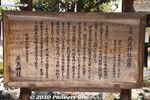
About Hyozu Taisha's Japanese garden. The garden dates back to the Heian Period. It was here even before the shrine moved here. The original garden was built by a local aristocrat named Harima-no-Kamisukeyori 播磨守資頼 who lived here in the KamaMay 30, 2010
|
|

This garden is also beautiful in fall when they light up the autumn leaves at night (see photos below).May 30, 2010
|
|

Monument for used and broken needles.May 30, 2010
|
|

Hyozu Taisha's Japanese garden, nationally noted as a famous garden. 兵主大社庭園May 30, 2010
|
|

Hyozu Taisha Shrine. It worships the same god as Izumo Taisha in Shimane Prefecture. Yachihoko is known as the god of military strength. Japan's famous warriors desired this god's blessings and so patronized this shrine.May 30, 2010
|
|

Pass through the Romon Gate and this 100-meter path goes straight to the shrine's Haiden Hall. May 30, 2010
|
|

After the red torii is this red Romon Gate, said to have been donated by Shogun Ashikaga Takauji. The shrine also has historic ties to Minamoto Yoritomo and the Tokugawa shoguns.May 30, 2010
|
|

Established in 717 (Nara Period), Hyozu Taisha worships a god named Onamuchi-no-Mikoto (大己貴命) also called Yachihoko (八千矛神). Onamuchi-no-Mikoto is a god of nation-building, farming, business, and medicine.May 30, 2010
|
|

Then turn left to see the Taikobashi Bridge and red torii.May 30, 2010
|
|

Front torii gate of Hyozu Taisha Shrine. MAPMay 30, 2010
|
|

After the front torii, there is a 300-meter gravel path lined with pine trees.May 30, 2010
|
|

Hyozu Taisha is amid rice paddies. The row of pine trees in the distance marks the path to the shrine. This is the view from the bus stop.May 30, 2010
|
|

Yasu's official mascot, named Dotaku-kun, is modeled after a dotaku.Mar 26, 2010
|
|

Way back to the torii.Mar 26, 2010
|
|

Mar 26, 2010
|
|

Mar 26, 2010
|
|

Mar 26, 2010
|
|

Mar 26, 2010
|
|

Osasahara Shrine's Honden Hall, a National Treasure. 大笹原神社 本殿Mar 26, 2010
|
|

On the left is Shinohara Shrine dedicated to Ishikoritome, the god of mochi rice cakes. The rice around here was said to be ideal for making mochi.Mar 26, 2010
|
|
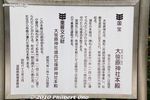
About Osasahara Shrine and Shinohara Shrine (in Japanese).Mar 26, 2010
|
|

Osasahara Shrine's Honden Hall. The shrine dates from the mid-Heian Period. It is dedicated to a god named Susano-o.Mar 26, 2010
|
|

Osasahara Shrine's Honden Hall, a National Treasure in Yasu, Shiga. The shrine dates from the mid-Heian Period. It is dedicated to a god named Susano-o. 大笹原神社 本殿Mar 26, 2010
|
|

Osasahara Shrine's Haiden Hall is what you first see when you enter the shrine grounds.Mar 26, 2010
|
|

Beyond the Haiden Hall is the Honden Hall (right) and the small Shinohara Jinja Shrine on the left which happens to be an Important Cultural Property. A fence prevents you from getting closer.Mar 26, 2010
|
|

Osasahara Shrine torii. MAPMar 26, 2010
|
|

Soon you'll see this fork in the road. Go right.Mar 26, 2010
|
|

From the Oshinohara intersection, turn right into the road and walk. Cross the river. It's a quiet rural neighborhood.Mar 26, 2010
|
|

From JR Yasu Station, take a bus to Oshinohara which is this intersection. 大篠原Mar 26, 2010
|
|

Path to Osasahara Shrine.Mar 26, 2010
|
|

From JR Yasu Station's South exit (Minami-guchi), take a bus going to Karyoku Koen (花緑公園) or Murata Seisakusho (via Nishi Gate 西ゲート経由 村田製作所行き) and get off at Dotaku Hakubutsukan-mae (銅鐸博物館前). Bus ride is Mar 26, 2010
|
|

Yamanokami mountain god monumentMar 26, 2010
|
|

Mar 26, 2010
|
|

Mar 26, 2010
|
|

Mar 26, 2010
|
|

Mar 26, 2010
|
|

Mar 26, 2010
|
|

Mar 26, 2010
|
|

Mar 26, 2010
|
|

This elevated structure served as a storehouse.Mar 26, 2010
|
|

Mar 26, 2010
|
|

It would be a matter of time before walls were constructed below the roof.Mar 26, 2010
|
|

Mar 26, 2010
|
|

Some pots inside a hut.Mar 26, 2010
|
|

The ceiling has square beams.Mar 26, 2010
|
|

Mar 26, 2010
|
|

Mar 26, 2010
|
|

Mar 26, 2010
|
|

Inside a Yayoi-Period grass shack.Mar 26, 2010
|
|

Mar 26, 2010
|
|

This is how the dotaku were buried. Mar 26, 2010
|
|

Mar 26, 2010
|
|

Mar 26, 2010
|
|

Adjacent to the Dotaku Museum is a replica of a Yayoi Period village. Yayoi Period (500 BC to 300 AD) is noted as when rice growing started in Japan.Mar 26, 2010
|
|

These ancient abode were pretty much a hole in the ground with a roof over it.Mar 26, 2010
|
|
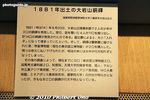
Two of the dotaku were acquired by the Tokyo National Museum. The remaining dotaku were scattered among various people. Their whereabouts were unknown until an investigation found 12 of them at temples and Japanese and overseas museums.Mar 26, 2010
|
|

Monument marking the site where the dotaku were found. In 1962, ten more dotaku were found in Yasu.Mar 26, 2010
|
|

Monument marking the site where the dotaku were found. It's frustrating that none of the original dotaku discovered in Yasu are in Yasu. Another case of bungling and ineptness by local officials. Even one original dotaku would make the museum busier.Mar 26, 2010
|
|

Mold for making a dotaku. Yasu's dotaku found their way to the following overseas museums: Museum of East Asian Art in Cologne (Germany), Asian Art Museum of San Francisco (USA), and Minneapolis Institute of Arts (USA).Mar 26, 2010
|
|

The dotaku were nestled inside each other. These bells are dated from around 100 BC to 300 AD. The bells were not really used as bells. They were more for decorative and religious purposes.Mar 26, 2010
|
|

Normally, the largest dotaku is not exhibited here. It is in the Tokyo National Museum.Mar 26, 2010
|
|
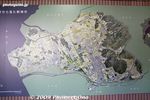
Satellite view of Yasu.Mar 26, 2010
|
|

Mar 26, 2010
|
|

Replica of Japan's largest dotaku found in Yasu.Mar 26, 2010
|
|

Replica of Japan's largest dotaku found in Yasu.Mar 26, 2010
|
|

"Dotaku" means bronze bell. This one decorates the entrance of the Dotaku Museum in Yasu. MapMar 26, 2010
|
|

On Aug. 20, 1881, two young lads were playing on Mt. Oiwa when they stumbled across three dotaku partially exposed in the ground. The next day, eleven more dotaku were discovered in the same area.Mar 26, 2010
|
|
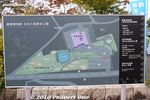
Map of the Dotaku Museum and Yayoi no Mori Park featuring Yayoi Period grass shacks. Dotaku Museum is a short bus ride from JR Yasu Station. Take the bus which goes to Dotaku Hakubutsukan-mae.Mar 26, 2010
|
|

Dotaku Museum in Yasu, Shiga Prefecture. Opened in Nov. 1988, the museum is near the site where Japan's largest bronze bell was unearthed. It has bronze bell exhibits and research facilities. Open 9 am to 5 pm (closed Mon.). Admission 400 yen.Mar 26, 2010
|
|
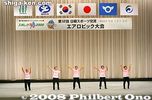
The city of Maibara hosted the Sports Recreation aerobics tournament on Oct. 19-20, 2008. These are women in their 80s and 90s dancing. They were one of the winners.Nov 02, 2008
|
|

Joint session.Nov 02, 2008
|
|

Paint it yourself.Nov 02, 2008
|
|
|

Free shuttle buses took us from Kibogaoka Park and Yasu Station (or nearby parking lots).Nov 02, 2008
|
|

Miyazaki's booth.Nov 02, 2008
|
|

Sports Recreation Shiga 2008 aerobics tournament in Maibara.Nov 02, 2008
|
|

Caffy-yaki sweet bean buns were popular.Nov 02, 2008
|
|

Ayu sweetfishNov 02, 2008
|
|

Exit. The booths and other festivities were held at Kibogaoka Park only during Oct. 18-19, 2008. While the sports tournaments were held at various venues until Oct. 21st. Official site here.Nov 02, 2008
|
|

Kibogaoka ParkNov 02, 2008
|
|

Miyazaki Governor Higashikokubaru is a celebrity and Miyazaki's top salesman. Unfortunately, this is only a cardboard cutout of him.Nov 02, 2008
|
|

Sake from ShigaNov 02, 2008
|
|

Ibuki goodies (Maibara)Nov 02, 2008
|
|

Nov 02, 2008
|
|

Caffy-yaki sweet bean bun.Nov 02, 2008
|
|

Caffy dollNov 02, 2008
|
|

The west side of the park had food and souvenir booths.Nov 02, 2008
|
|

There were these large tents for resting and eating.Nov 02, 2008
|
|

Most people tried to stay out of the hot sun.Nov 02, 2008
|
|

Ryukoku University band entertains.Nov 02, 2008
|
|

Caffy mascot dollsNov 02, 2008
|
|

Booth for the city of Yasu.Nov 02, 2008
|
|

Food boothsNov 02, 2008
|
|

Blow dartsNov 02, 2008
|
|

Yasu's booth had a replica of an ancient bronze bell, Japan's largest discovered in Yasu.Nov 02, 2008
|
|

Free acupuncture.Nov 02, 2008
|
|

There were various health-related booths. Free shoulder/head massages here.Nov 02, 2008
|
|

Earthquake simulatorNov 02, 2008
|
|

Jumping rope en masse.Nov 02, 2008
|
|

Nov 02, 2008
|
|

Throwing BingoNov 02, 2008
|
|

Nov 02, 2008
|
|

Nov 02, 2008
|
|

Sculpture for the Sky.Nov 02, 2008
|
|

Sculpture for Humans.Nov 02, 2008
|
|

Nov 02, 2008
|
|

Toward the east side of the park was an area where you could try various new sports.Nov 02, 2008
|
|

They had a whole bunch of Caffy mascots walking around. Caffy is modeled after the Lake Biwa Giant Catfish, a unique species found only in Lake Biwa.Nov 02, 2008
|
|

Nov 02, 2008
|
|

Sculpture for Water.Nov 02, 2008
|
|

Spo-rec flagsNov 02, 2008
|
|

Caffy, the official mascot of Sports Recreation Shiga 2008, is modeled after the Lake Biwa Giant Catfish, a unique species found only in Lake Biwa.Nov 02, 2008
|
|

FlagsNov 02, 2008
|
|

Wish they actually flew the kite, but I guess there wasn't enough room.Nov 02, 2008
|
|
|

A tall crane hoists up the Yokaichi giant kite.Nov 02, 2008
|
|

This giant kite is actually an old one, from several years ago. They took it down after the opening ceremony was over.Nov 02, 2008
|
|

Another activity for the sky...Nov 02, 2008
|
|

For the finale, they released these little balloons shaped like doves. This was to represent the sky.Nov 02, 2008
|
|

Dove balloons in the sky.Nov 02, 2008
|
|

A taiko troupe performs.Nov 02, 2008
|
|

Nov 02, 2008
|
|

The ground transformed into a lake.Nov 02, 2008
|
|

The next activity, representing water, was having a huge blue sheet covering the spectators. The opening ceremony had a theme based on water, humans, and the sky.Nov 02, 2008
|
|

Then they tossed these small balls onto the sheet where they bounced all over.Nov 02, 2008
|
|

Over 20,000 people competed in the sports tournaments held all over Shiga. They included soccer, softball, badminton, bowling, track, gate ball, folk dancing, aerobics, and trampoline.Nov 02, 2008
|
|

This sports meet is designed for adults of all ages. You can be 95 years old and still participate. They call it a "life-long sports meet."Nov 02, 2008
|
|

Giant balls were tossed to the audience. They slapped the balls toward the front, but many of them popped like a balloon.Nov 02, 2008
|
|

Caffy capNov 02, 2008
|
|

The contingent from South Korea also marched to their seats from the center stage.Nov 02, 2008
|
|

On the right was a large stage for the band.Nov 02, 2008
|
|

Large monitor shows Governor Kada declaring the opening of the Spo-rec event.Nov 02, 2008
|
|

The opening ceremony stage was at the front and center, looking very tiny to most of us. Shiga Governor Yukiko Kada is in a yellow pants suit.Nov 02, 2008
|
|

NaganoNov 02, 2008
|
|

ShigaNov 02, 2008
|
|

TokyoNov 02, 2008
|
|

Flags for all the prefectures.Nov 02, 2008
|
|

Athletes from Miyazaki Prefecture hold a sign saying "See you next year in Miyazaki!"Nov 02, 2008
|
|

Shiga athletes applaud as the different athletes marched past.Nov 02, 2008
|
|

Each flag had the name of the prefecture. This is Miyazaki.Nov 02, 2008
|
|

GunmaNov 02, 2008
|
|

Then representatives from all 47 prefectures marched through the crowd.Nov 02, 2008
|
|
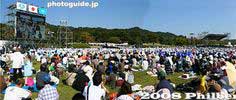
Sports Recreation Shiga 2008 opening ceremony at Kibogaoka Park, Yasu on Oct. 18, 2008. It was a sunny, cloudless day, and quite hot in sun. スポレク滋賀 開会式Nov 02, 2008
|
|

The opening ceremony started at 12:30 pm with a line of Caffy flags each representing a different sport.Nov 02, 2008
|
|

Athletes from Shiga at the opening ceremony.Nov 02, 2008
|
|

Mt. Mikami (Shiga's Mt. Fuji) overlooks the park.Nov 02, 2008
|
|

Site of the opening ceremony held on Oct. 18, 2008 at the center part of Kibogaoka Park.Nov 02, 2008
|
|

Hand sculpture.Nov 02, 2008
|
|

What are these large balls for? We'll find out soon.Nov 02, 2008
|
|

Jamie and Megan Thompson sing "Lake Biwa Rowing Song" at Sports Recreation Shiga 2008 on Oct. 18, 2008 in Kibogaoka Park, Yasu, Shiga Pref.Nov 02, 2008
|
|

Jamie and Megan Thompson sing "Lake Biwa Rowing Song" at Sports Recreation Shiga 2008 on Oct. 18, 2008 in Kibogaoka Park, Yasu, Shiga Pref.Nov 02, 2008
|
|

Then at 10:20 am, Jamie and Megan Thompson from Illinois, USA appeared and sang "Lake Biwa Rowing Song" (Biwako Shuko no Uta in English). スポレク滋賀、県民「夢」ステージNov 02, 2008
|
|

MC Chiho Ono from FM Shiga (e-radio) asks the twins a few questions. Also see the video here. 司会者 小野千穂Nov 02, 2008
|
|

A duo called Mellow Pair also performed. The keyboard player is from Shiga, while the singer on the right is from Miyazaki Prefecture which is the host of next year's Sports Recreation event in 2009.Nov 02, 2008
|
|

Abbreviated "Spo-rec," this event was a very big deal for Shiga with over 20,000 visiting Shiga. Kibogaoka Park is a huge grassy park. There was an entertainment stage called Kenmin Yume Stage which can be seen at the center of this photo.Nov 02, 2008
|
|

Entrance to Kibogaoka Park during the Sports Recreation Shiga 2008 festival during Oct. 18-21, 2008. It's an annual event held in a different prefecture. People from all 47 prefectures and South Korea participate in tournaments for 18 sports.Nov 02, 2008
|
|

On the first day Oct. 18, 2008, this stage featured an entertainment program from 9:30 am to 11:15 am. It included this balloon session for kids.Nov 02, 2008
|
|

Rear view of Haiden and Two-story GateMay 29, 2008
|
|

Mikoshi portable shrine storehouseMay 29, 2008
|
|

Wakamiya Shrine on the left of the Honden. 若宮社May 29, 2008
|
|

HondenMay 29, 2008
|
|

Sannomiya Shrine of the right of the Honden. 三宮社May 29, 2008
|
|

Rear view of HondenMay 29, 2008
|
|

Mikami Shrine's Honden in Yasu, a National Treasure. It is a mixture of Shinto shrine and Buddhist temple architecture. It dates from the Kamakura Period, about 700 years ago. 本殿May 29, 2008
|
|

Mikami Jinja's Honden. This was Shiga's first Shinto shrine building to be designated as a National Treasure. 本殿May 29, 2008
|
|

Honden (left) and Haiden. The shrine worships a deity called Amenomikage. The shrine also has Mt. Mikami as a sacred mountain. 天之御影命May 29, 2008
|
|

Rear view of HondenMay 29, 2008
|
|

Haiden worship hall 拝殿May 29, 2008
|
|

Figure in gateMay 29, 2008
|
|

Haiden worship hall, Important Cultural Property. 拝殿May 29, 2008
|
|

Two-story Romon Gate, Important Cultural Property. 楼門May 29, 2008
|
|

Front torii of Mikami ShrineMay 29, 2008
|
|

Rear torii gate of Mikami ShrineMay 29, 2008
|
|

After you get off the bus at Mikami Jinja-mae, you see this small road leading to the rear entrance of the shrine. MAPMay 29, 2008
|
|

Front entrance and torii gate of Mikami ShrineMay 29, 2008
|
|

May 29, 2008
|
|

May 29, 2008
|
|

Almost finished planting the rice in this paddy. The festival was over after 11 am.May 29, 2008
|
|

May 29, 2008
|
|

Rice-planting Festival in Yasu, Shiga Prefecture with Mt. Mikami in the background. Also see my YouTube video here.May 29, 2008
|
|

May 29, 2008
|
|
|

May 29, 2008
|
|

May 29, 2008
|
|

Rice-planting festival dancer, Yasu, Shiga Pref.May 29, 2008
|
|

May 29, 2008
|
|

The rice paddy actually consists of four square paddies divided by cross-shaped ridges. When you see it from above, it looks like the kanji "ta" 田 which means rice paddy.May 29, 2008
|
|

May 29, 2008
|
|

A gate with sacred ropeMay 29, 2008
|
|

They also had a short break.May 29, 2008
|
|

Young children also joined in the singing.May 29, 2008
|
|

A local troupe of Taiko drummers called "Mukade Taiko." Mukade means centipede. Mt. Mikami is famous for a folk tale about a giant centipede which occupied the mountain. It was later killed by a brave warrior from Otsu.May 29, 2008
|
|

The Yuki Saiden rice paddy is in a scenic, rural location, with Mt. Mikami in the background. You can understand why it was selected to be the Yuki Saiden in 1928.May 29, 2008
|
|

May 29, 2008
|
|

May 29, 2008
|
|

Woman planting rice at the rice-planting festival in Yasu, Shiga Prefecture.May 29, 2008
|
|

May 29, 2008
|
|

May 29, 2008
|
|

Rice seedlings in hand.May 29, 2008
|
|

Rice-planting festival dancer, Yasu, Shiga Pref.May 29, 2008
|
|

This rice paddy was used to produce the rice used for a ritual called the Daijosai as part of the Showa Emperor's accession ceremonies in 1928. Selected by the Imperial Household Agency, the Yuki Saiden sacred rice paddy must be east of Kyoto. 悠�May 29, 2008
|
|

They wear a sedge hat (suge-kasa すげ笠), red trousers (緋ばかま), wrist covers (手甲), and leggings (脚絆).May 29, 2008
|
|

May 29, 2008
|
|

For the Daijosai, another sacred rice paddy is also selected to the west of Kyoto. That paddy is called Suki Saiden. In 1928, it was located in Fukuoka Pref.May 29, 2008
|
|

On the ridges were women dancers.May 29, 2008
|
|

In the background is cloud-capped Mt. Mikami.May 29, 2008
|
|

Ready to sink into the paddy.May 29, 2008
|
|

It is a great honor to be selected as the sacred rice paddy for an emperor's accession to the throne. The Yuki Saiden paddy for the current Emperor Akihito was in Akita Pref.May 29, 2008
|
|

May 29, 2008
|
|

Their feet are more than ankle deep in the mud. No one lost their balance and fell into the mud.May 29, 2008
|
|

When the taiko drumming and folk singing started, they started planting the rice seedlings. On the ridge, there were dancers.May 29, 2008
|
|

At 10:30 am when the ceremony was over, they proceeded to the rice paddies. Four groups of planters and dancers went to the four paddies.May 29, 2008
|
|

May 29, 2008
|
|

First they threw bunches of rice seedlings into the paddy.May 29, 2008
|
|

Everyone took off their straw sandals and went into the paddies barefoot.May 29, 2008
|
|

Rice-planting Festival Shinto ceremony. A torii stands next to the rice paddy. MAP For more info: Yasu Tourism FBMay 29, 2008
|
|

On the fourth Sunday in May, the Yuki Saiden O-taue Matsuri, or Rice-planting Festival is held here. It starts at 10 am with a Shinto ceremony with the planters and local dignitaries in attendance in front of the rice paddy.May 29, 2008
|
|

Although a Shinto priest from Mikami Shrine conducts the ceremony, the festival is organized by the Yasu Tourist Association. The rice planters and dancers are from a local rice-planting preservation group.May 29, 2008
|
|

This rice paddy near the foot of Mt. Mikami and next to Mikami Shrine was used to produce the rice offering used for the Showa Emperor Hirohito's accession to the throne in 1928. Such a paddy is called Yuki Saiden. 悠紀斎田May 29, 2008
|
|

West Gate for car parking. Bus stop on right.Apr 07, 2008
|
|

Softball fieldApr 07, 2008
|
|

Apr 07, 2008
|
|

Cherry blossoms and softball fieldApr 07, 2008
|
|

MushroomsApr 07, 2008
|
|

Apr 07, 2008
|
|

Grass slideApr 07, 2008
|
|

Shallow streamApr 07, 2008
|
|

Apr 07, 2008
|
|

Large grassy lawn.Apr 07, 2008
|
|

West gate (Nishi Gate) to Kibogaoka Culture Park, a large prefectural park featuring a large grassy lawn, sports facilities, camping facilities, and seminar facilities. MAPApr 07, 2008
|
|

Mt. Mikami in the distance.Apr 07, 2008
|
|

Apr 07, 2008
|
|

Apr 07, 2008
|
|

Apr 07, 2008
|
|

Sato no Ie thatched-roof house now a display space. 里の家Apr 07, 2008
|
|

Inside Sato no IeApr 07, 2008
|
|

Apr 07, 2008
|
|

Grassy lawnApr 07, 2008
|
|

Apr 07, 2008
|
|

This park and surrounding area has a number of different things to see and do. Walk further more and you will reach Kibogaoka Park.Apr 07, 2008
|
|

Mt. Mikami and slideApr 07, 2008
|
|

Furusato Yakata for nature workshopsApr 07, 2008
|
|

Bridge over the highwayApr 07, 2008
|
|
|
|